The Future of Artificial Intelligence (AI)
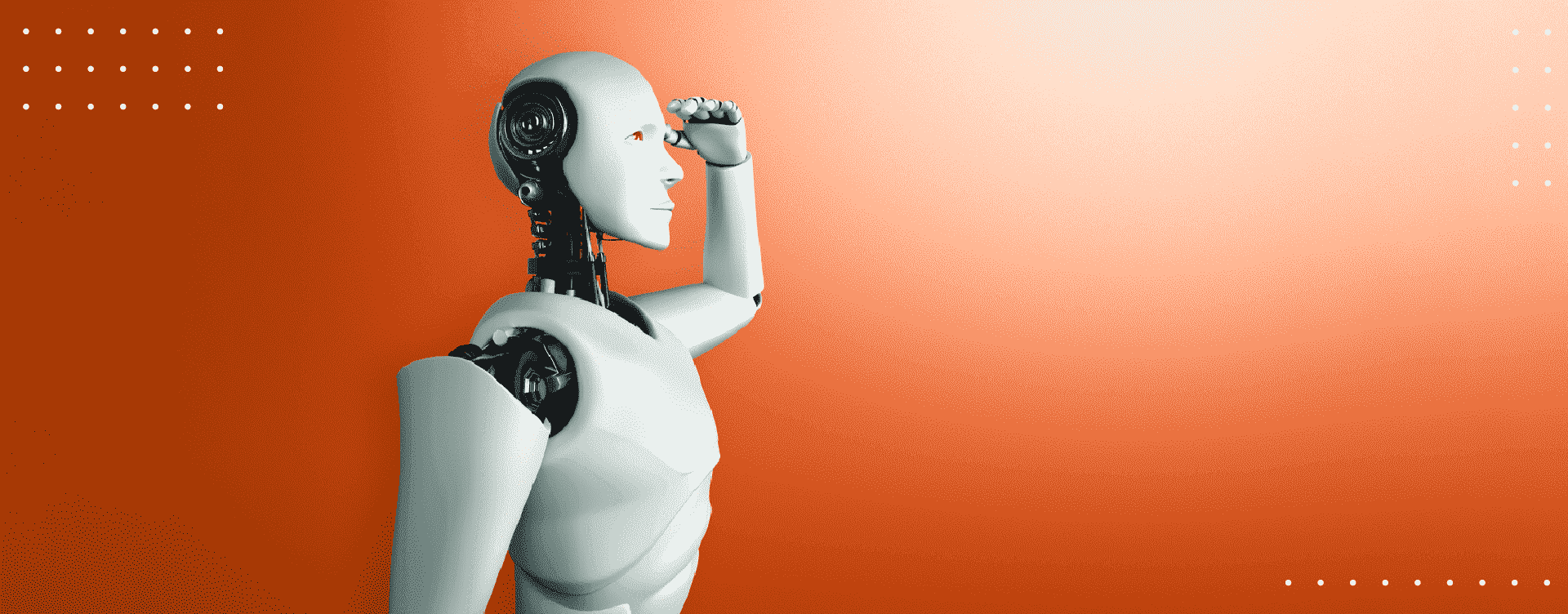
Key takeaways
- Learn more about AI technologies and explore the thorny path of AI history, from the birth of technology to the integration of artificial intelligence into our daily lives.
- Find out which industries have already been impacted by AI and in which way it has facilitated their transformation.
- AI can help people with routine tasks, create opportunities for new jobs, and automate many business processes. Read more about the beneficial aspects of AI and explore how it affects society.
- There are numerous myths and misconceptions about AI, including the idea that it will take over many jobs, control the world, and develop on its own, among others. So why let them take over? Let’s dispel these and other myths together.
- Wondering what the development of AI technology will be in the future and whether the synergetic coexistence of AI and business is possible? Then, discover AI trends to keep up with important tech industry changes in the coming years.
As we move along the complex path of AI development, we see that human ingenuity and relentless curiosity push the boundaries of machine intelligence. This drive not only beckons us to new frontiers but also raises concerns and makes us wonder about the ever-changing landscape of the future of artificial intelligence.
So, if you wonder what AI’s current state is and what to expect from AI in the future, this article is for you. Especially considering the fact that 35% of companies are already using it and 42% are exploring it for future integration, it’s always better for businesses to keep up with the tech industry changes. In this article, we will explore the history of AI, what areas of our lives and businesses it is integrated into, and dispel many myths and speculations. So, put all the confusion, prejudice, and doubts aside, and let’s explore why we should be perceived not as the enemy but as an ally and assistant instead.
What is AI?
It’s time to explore AI meaning in detail. AI, or artificial intelligence, imitates human intelligence in machines programmed to solve complex and intricate problems and mimic human cognitive activity. These machines are designed to perform tasks that usually require human intelligence, such as understanding natural language, recognizing patterns, and adapting to new information.
It’s worth noting that AI is an umbrella term that encompasses various emerging technologies and approaches, including machine learning, neural networks, natural language processing (NLP), deep learning, computer vision, and others. By automating processes, improving data analysis, generating valuable insights, and improving decision-making, it has the potential to revolutionize multiple industries and improve aspects of our lives, including healthcare, finance, entertainment, and others.
AI continues to evolve rapidly and holds great promise for the future, enabling various kinds of technologies AI-capable. For instance, today, artificial intelligence is present in over 77% of gadgets in one form or another.
Along with the AI evolution, people are becoming interested in discovering more about the future of AI and the coexistence of humanity with it. We wonder if robots will ever match or surpass human intelligence. While business owners wonder whether they should use AI to expand the capabilities of their products. But before exploring all these, whether AI is our friend or foe, let’s explore briefly its evolution and see at what stage it is now.
The evolution of AI
Although the term artificial intelligence was formally introduced in the mid-20th century, creating intelligent systems has excited the human imagination for centuries. Since its inception in the 1950s, the field of artificial intelligence has embarked on a meteoric journey. Over the past few decades, AI has undoubtedly made significant advances, changing how we think about the capabilities of human cognition. However, it has also yet to realize some of its grand promises. In this section, we offer you to go through the history of AI, find out its turning points and significant achievements, and how AI is changing the world.
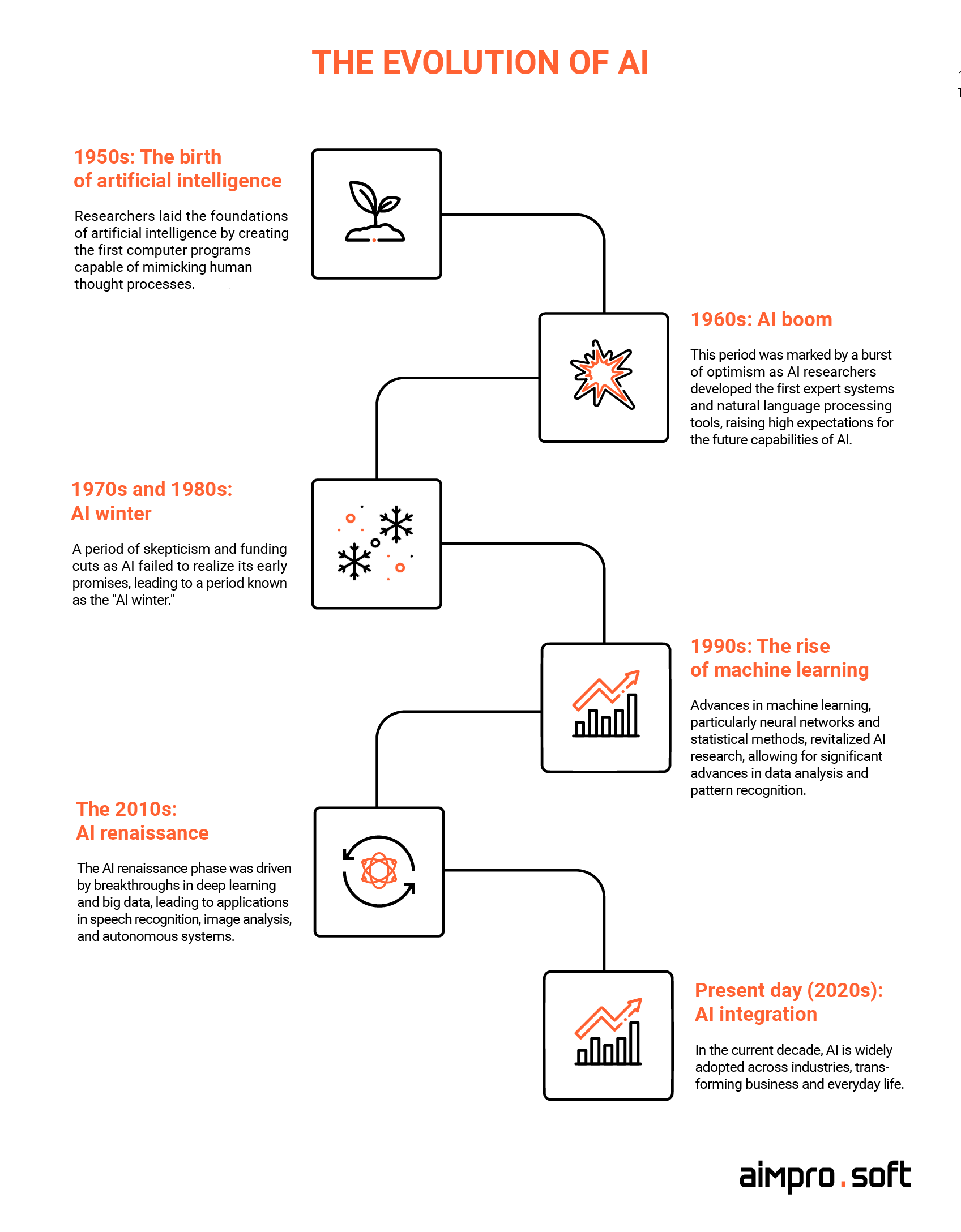
The evolution of AI by way of example of key milestones
1950s: The birth of AI
The 1950s saw the birth of AI as a formal concept. For instance, Alan Turing, the founder of modern computer science, proposed a method to measure the intelligence of a machine. In his seminal work “Computing and Intelligence,” Turing reformulated “Can a machine think?” and laid the theoretical foundations of machine intelligence. The first AI programs, such as Logic Theorist, aimed to simulate human problem-solving.
1960s: AI boom
The 1960s witnessed a significant surge in AI research and development. Researchers were optimistic about creating intelligent machines. Programs such as General Problem Solver demonstrated the problem-solving capabilities of AI. The term artificial intelligence became widespread. In addition, the development of artificial neural networks for learning and pattern recognition began in the late 1950s and early 1960s. Frank Rosenblatt’s “Perceptron” method, which was able to distinguish between geometric shapes and recognize images, is possibly the best illustration of the work that has been done in this area.
1970s and 1980s: AI winter
The 1970s brought challenges for AI. Unrealistic expectations and technological limitations led to reduced funding, known as the AI winter. The “winter” of AI in the early 1980s was momentarily broken by a period of prosperity brought on by the introduction of commercial expert systems. The first example of an expert system was the DENDRAL system developed in 1965 by Edward Feigenbaum. Expert systems have become widely employed for various everyday tasks, including natural language processing, medical diagnosis, computer hardware customization, and other routine tasks.
1990s: Rise of machine learning
In the 1990s, AI started embracing machine learning, allowing systems to learn from data. Neural networks and deep learning techniques emerged, enabling AI to tackle more complex tasks. As a result, significant progress was made in computer vision, robotics, natural language processing, and speech recognition. It was a novel method that produced a new wave of spectacular outcomes and improved theoretical comprehension of several fundamental AI ideas.
Want to know more about the development of machine learning and how it transforms industries? Then, read our detailed article on the topic.
2010s: AI resurgence
The 2010s witnessed a resurgence of AI, primarily driven by advancements in deep learning and reinforcement learning. Early in the 2010s, deep learning began to take off due to the work of individuals like Yoshua Bengio, Geoffrey Hinton, and Yann Le Cun. AI systems achieved remarkable success in image recognition, natural language processing, and virtual assistants.
Present (2020s): AI integration
AI is deeply integrated into various areas of our lives and industries. AI powers autonomous vehicles, aids in healthcare diagnostics, and is used extensively in financial services and manufacturing. AI-driven innovations continue to transform the way we live and work. Self-driving cars and smart home devices are tangible examples of AI shaping the future of transportation and home automation. Moreover, AI’s influence extends to finance, cybersecurity, and education, where it aids in fraud detection, threat analysis, and personalized learning. The 2020s have witnessed AI’s evolution from a promising technology to an integral part of modern society, impacting nearly every industry and aspect of daily life.
Good examples of AI applications in various business areas include tools such as TensorFlow, a machine learning framework developed by Google that has found applications in healthcare, finance, and the automotive industry. PyTorch is widely used in research and industry. It is used in computer vision, speech recognition, and recommender systems. Likewise, Scikit-Learn is a machine-learning library in the Python language. It is used in industries such as finance for credit scoring and fraud detection.
And another good example of how AI technology is coming into our daily lives is GPT technology and GPTchat. Its ability to generate human-like text and natural dialogue has become a testament to the significant progress made in AI over the years.
Interested in finding out more about the development of GPT, its capabilities, and business benefits? Get answers in our article on the topic.
The history of AI development has experienced many ups and downs. Still, this technology continues its rapid development, and we are getting closer to seeing science fiction concepts turning into reality. At the end of this section, we discussed how AI technology is becoming part of our everyday lives. So let’s see in which exact areas of our lives AI is most often used and answer the question of how will AI change the world.
What industries is AI changing already, and what are further prospects?
AI has emerged as a transformative force, revolutionizing industries. Its impact is profound, enhancing efficiency, reducing costs, and unlocking new possibilities. Transparency Market Research (TMR) conducted a study that predicts the global artificial intelligence market will reach $3,061.35 billion by the end of 2024, compared to $126.14 billion back in 2015. This fact shows that AI is the future and is only developing and capturing the market. In turn, more companies will continue integrating AI and related emerging technologies for business development. Let’s see together how will artificial intelligence change the future.
Sectors significantly impacted by AI
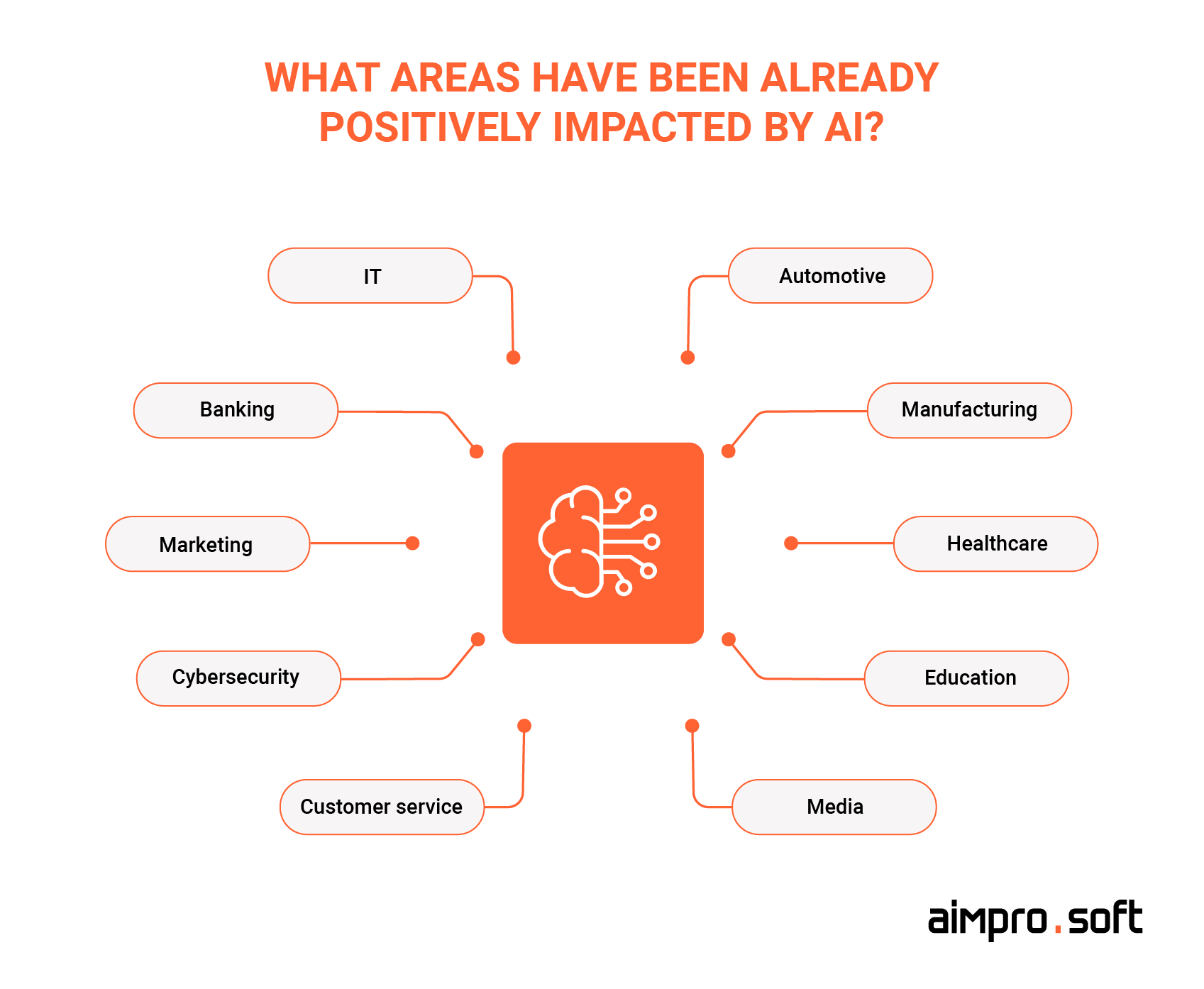
Areas in which AI technologies are actively used
Automotive
Artificial intelligence is revolutionizing the automotive industry with self-driving cars, and AI-driven features such as advanced driver assistance systems (ADAS). AI also optimizes supply chains, provides voice and gesture control, improves navigation, improves fuel efficiency, monitors driver behavior, and enhances safety. This improves the overall driving experience and increases customer satisfaction. Autonomous vehicles have been created by businesses like Tesla and Waymo that employ AI to navigate highways safely. These innovations aim to make transportation safer and more effective. AI will have a significant impact on the transport industry with the use of self-driving cars.
Manufacturing
AI is already streamlining operations in manufacturing with predictive maintenance, quality control, and supply chain optimization. By harnessing the power of artificial intelligence, manufacturers can minimize downtime, enhance product quality, and streamline their production processes. Artificial intelligence systems use data from sensors to forecast when equipment will need maintenance, minimizing downtime and saving money. For instance, General Electric’s aviation sector employs AI for predictive maintenance.
Healthcare
The future of Artificial Intelligence in healthcare spans a wide range of areas, from clinical outcome prediction using electronic health records to early detection utilizing radiological image analysis. Already, AI helps manage and secure vast volumes of patient data, ensuring privacy and compliance. IBM’s Watson Health, for example, assists in interpreting medical images, helping doctors make more accurate diagnoses. Additionally, chatbots like Woebot provide mental health support, enhancing accessibility to healthcare services.
Want to know how machine learning is being successfully integrated into healthcare? Read our in-depth guide on this topic.
Education
AI is employed in education for plagiarism detection, ensuring exam integrity, and supporting enrollment through chatbots while enhancing learning experiences through personalized learning management systems and facilitating academic research by analyzing student success metrics.
Companies like Coursera utilize AI algorithms to recommend courses tailored to learners’ preferences and abilities. These platforms analyze student progress and performance data, creating customized learning paths that cater to individual strengths and weaknesses. Moreover, AI has enabled adaptive assessments that adjust to a student’s skill level, providing a more accurate evaluation of their knowledge.
Media
AI brings many innovations to the media sphere, such as personalizing content recommendations, optimizing content creation through automatic article generation, and improving media search through video and image analysis. For example, Netflix employs AI to suggest personalized content, and AI algorithms generate news articles on platforms like the Associated Press. Netflix is enhancing the user experience with its recommendation system based on machine learning and AI.
This system analyses viewing history, including up or down scores, time and location of viewing, ‘repeat viewing’ habits, and more. As a result, it makes accurate predictions and recommendations, ultimately increasing user satisfaction and attracting more subscribers.
Customer service
Customer service is already being disrupted by AI. In the guise of chatbots, natural language processing (NLP) algorithms have made their way into customer-facing helplines. These chatbots can gather details about a customer’s problems and help customer service representatives work more effectively. Companies like Zendesk and Intercom use AI chatbots to respond to customer inquiries and provide support 24/7, improving the rate of customer satisfaction.
Cybersecurity
The capacity of AI to identify and address threats in real time is one of the technology’s main advantages in cybersecurity. Networks, endpoints, and other devices can be monitored by security systems driven by artificial intelligence (AI) to look for anomalies, patterns of unusual activity, and other possible signs of security threats. Darktrace employs AI to identify abnormal network behaviors, helping organizations defend against cyberattacks.
Marketing
Many marketers can no longer imagine their lives without AI tools, with 90% of marketers claiming that AI, particularly the automation it enables, helps them spend less time on manual tasks, ultimately streamlining their operations and generating data-driven insights. AI is used for SEO optimization, the creation of email newsletter headlines, and finding content ideas quickly. Intelligent automation revolution and AI-based solutions have already emerged and are being used. Google Ads uses AI to determine the most effective ad placements and audience targeting, improving marketing ROI.
Banking
AI technology is being used for banking for different purposes. A variety of uses for AI in banking have been reported. For instance, to use chatbots to improve customer service, identify fraud, and optimize investments. Capital One, for instance, employs virtual card numbers to guard against credit card fraud. The business is also focused on computational creativity, which teaches computers to be original and comprehensible.
Additionally, AI algorithms help banks detect fraudulent activities and improve risk assessment. The accuracy and speed with which AI can handle data will result in a better, more individualized client experience. Banking organizations that are not yet utilizing AI will eventually be forced to upgrade if they want to stay competitive.
IT
If you think AI technology will be able to replace developers in the near future, it won’t, and you still need developers. But AI technology future in the IT world has something else to offer. With AI-based emerging technologies, computers can solve specific problems by analyzing vast amounts of data and recognizing recurring patterns. All of this serves as an aid to modern developers and can speed up the product development process.
This is what our data scientist D.Shevchenko thinks about the future of AI in the IT industry:
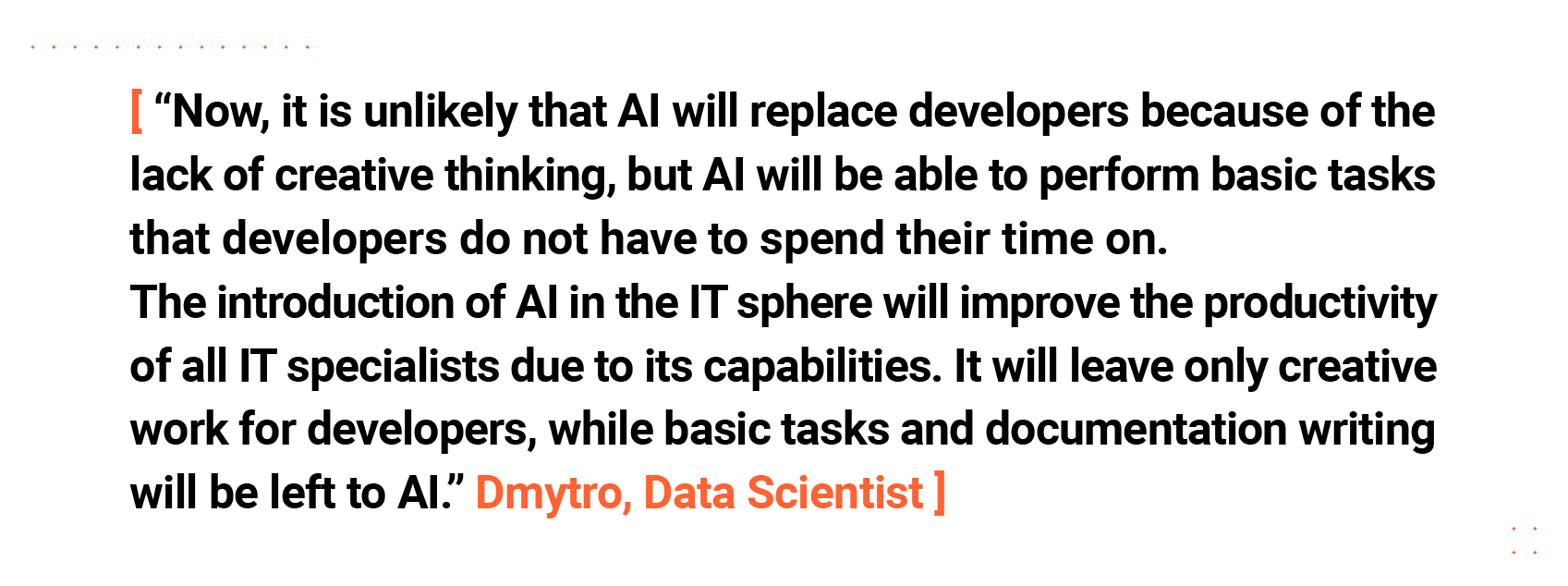
These are just a few examples of how AI is transforming various domains, and the list goes on as AI technology continues to evolve rapidly. We’ve covered the main aspects of AI’s impact on business, but what about AI’s influence on society? Let’s see what these technologies have brought to our daily lives and how artificial intelligence will change the world.
The impact of AI on society
Since the beginning of ancient times, people have been thinking about the possibility of artificial intelligence, such as the ancient Greeks, whose mythology described a giant bronze robot named Talos who guarded the island of Crete, throwing stones at pirates and invaders. In the 20th century, society’s interest in AI was fuelled by many writers and filmmakers inspired by scientific works and speculations about the development of AI. For example, in Philip K. Dick’s “Do androids dream of electric sheep?” also known as “Blade Runner,” where robots that look like humans and think almost like humans coexist with people on the same scale.
In today’s world, we already exist on almost the same scale as artificial intelligence. Even if not at the level of science fiction, we can already communicate with AI about our daily activities or ask for help in our work from artificial intelligence. All of this stuns the imagination and leads us to the actual life realization of sci-fi creations every day, closer and closer. Human-AI collaboration has already entered many areas of our lives. We can already use self-driving cars, visually impaired people can use bots to voice important information to them, and the lights and temperature in our homes can be controlled by Internet of Things gadgets that are powered by artificial intelligence.
And that’s just a short list of how AI technologies are used nowadays and how they assist people. In this section, we will look more closely at the impact of AI on society.
Economic transformation
AI is essential to the positive growth of the economy. According to studies, using AI can increase GDP and productivity, which will promote economic growth. However, AI’s effect on employment is not uniform because it may result in job displacement in some industries while opening up new career prospects in others.
What do Aimprosoft developers think about how will artificial intelligence change the world?
Based on a survey we conducted among our software engineers, here’s a popular opinion: AI can be used to replace employees in life-threatening jobs. For example, drones and AI algorithms can help find missing people in dangerous environments, and robots controlled by AI can perform tasks to detect and disarm explosive devices, minimizing the risk to bomb disposal workers. This has a significant advantage, as safety and human life are paramount.
AI-based automation
Automation driven by AI technologies impacts employment by streamlining routine tasks. This raises concerns about job displacement, especially in sectors like retail, where cashier roles are automated, or manufacturing, where robots take over repetitive tasks.
New jobs and opportunities
AI creates new roles related to AI development, data science, and AI ethics. These include AI engineers, data analysts, and ethical AI consultants. Upskilling and retraining are essential for individuals to embrace these opportunities.
Ethical considerations
The ethical concerns regarding AI are of paramount importance as AI technologies become increasingly integrated into our lives. The necessity to address these ethical issues in the present is highlighted by ongoing discussions about control, power dynamics, and the possibility that AI will surpass human capabilities as engineers, ethicists, and legislators consider the future of AI. Let’s take a look at ethical issues related to the integration of AI into our daily lives.
Visibility and accountability
AI systems frequently function in an opaque manner, lacking clear insights into their decision-making processes. Especially in critical fields such as healthcare and autonomous driving, it’s crucial to have transparency about how decisions are reached and who should be held accountable, especially in cases of errors or harm. To address these challenges of opacity, researchers are actively enhancing the development of explainable AI, aiming to provide insights into a model’s fairness, accuracy, and potential biases.
Marginalization
In addition to having the correct data and well-crafted AI algorithms, access to AI technologies is crucial. Inequalities among communities are exacerbated by uneven access to AI essentials, such as data, algorithms, hardware, and expertise. This issue is worsened when AI systems primarily cater to privileged groups, leaving marginalized communities behind. Sharing resources, including open-source software, advanced AI models, accessible infrastructure, and tutorials, can help bridge this AI gap. Leading companies like Google, Facebook, and Amazon are taking steps to provide free access to some of these essential components.
Risk of misinformation
Over the past twenty-five years, artificial intelligence has advanced to the point where it can generate images and videos known as “deep fakes,” which closely resemble real ones. This technology has made it remarkably easy to manipulate content, raising concerns about misinformation and trust in various domains. While detection methods are improving, the rapid dissemination of false information on social media presents challenges. Developing tools to differentiate fact from fiction is essential, but for now, a healthy dose of skepticism is advisable when encountering such content, as seeing isn’t always believing.
Positive impacts
Artificial intelligence has brought transformational changes in various spheres of society. Above, we have already talked about the doubts and concerns of society towards AI technologies. But still, AI has and is bringing many positive impacts in our lives, making people’s daily tasks more accessible and efficient.
Simplifying everyday tasks
One of the foremost benefits of AI is its role in simplifying everyday tasks. AI-powered virtual assistants like Siri and Alexa have become invaluable tools for managing schedules, answering questions, and controlling smart devices. These AI-driven helpers have streamlined the way people interact with technology, making information and services more accessible.
The impact of AI on healthcare
By bringing significant innovations and improvements to the healthcare system, AI can prevent various risks and threats to human health. For example, AI-powered devices, like HealthSnap, can continuously monitor patients’ vital signs, enabling early detection of health problems and providing real-time data to healthcare professionals. AI has also enabled the development of medical imaging techniques to detect diseases at early stages, such as cancer screening.
AI aids in addressing the world’s climate issue
AI plays a crucial role in addressing the worldwide climate crisis. Its capacity to handle vast data volumes and discern patterns is immensely beneficial in tackling climate change. For instance, AI-powered systems are employed to manage energy consumption by automatically turning off heating and lights when users leave their homes. Additionally, AI contributes to modeling glacier melt and forecasting sea level increases, which enables taking proactive measures.
What does a senior Aimprosoft developer think about the positive impact of AI?

The impact of AI on society is undoubtedly profound and multifaceted. It has triggered a wave of positive changes, simplifying our lives, increasing productivity, and tackling complex problems such as climate change. As AI continues to advance and become increasingly relevant in our world, it is essential that we continue to invest in its research and improvement.
This entails investing in research and development and establishing laws and policies that support the ethical use of AI. The future of AI technology often seems frightening and unrevealing, reinforced by cinematic dystopian futures. The next chapter will dispel popular myths and answer these legitimate concerns.
Myths about advanced artificial intelligence
Myths about AI are being hyped with immense force in today’s world, but it is still important to realize that AI is a tool created and controlled by humans, designed to help us achieve our goals and improve our lives. By understanding its capabilities, limitations, and current ethical frameworks, we can confidently embrace AI and ensure that it remains a force for good. We will address society’s most frequent questions and prejudices towards AI and try to dispel all doubts.
AI is equally intelligent as humans
AI algorithms are complex computer instructions and differ significantly from the human brain. While modern AI, including neural networks, draws inspiration from the brain’s architecture, it’s important to note that AI doesn’t possess human-like thinking or emotions. Numerous cognitive processes are beyond AI’s capabilities, largely due to the intricate and not fully understood nature of the human brain. Without substantial advancements in AI and neuroscience, achieving the goal of replicating the human mind through programming remains challenging and distant.
AI is taking over jobs
The popular opinion that artificial intelligence will completely replace human jobs has a place but needs context. While AI may excel at specific tasks and reduce the need for some low-level jobs, such as data entry, it will not lead to mass unemployment. Many jobs today involve cognitive functions that AI cannot replicate as efficiently as humans. Rather than a complete replacement, AI will likely serve as a tool to augment existing processes, requiring employees to upskill and adapt to new positions that utilize AI as a valuable tool. So, while there is some truth to this concept, it is a limited view, primarily applicable to specific job categories and applies to the artificial intelligence future rather than the present.
One’s business will be better without AI
The assertion that a business would unequivocally perform better without AI oversimplifies a complex matter. Artificial intelligence is indeed beneficial for businesses. It enhances efficiency, decision-making, and customer experience. For example, AI algorithms are already being used to improve various business processes, such as enhancing report keeping and security.
However, AI’s impact on a business varies depending on the industry, specific applications, and the effectiveness of its implementation. While AI can optimize operations, cut costs, and boost competitiveness in particular sectors, it isn’t a one-size-fits-all solution. Implementing AI requires thoughtful consideration of unique circumstances and objectives. Thus, businesses need to assess their specific needs and evaluate the potential benefits of AI before making decisions.
AI will enslave humans
In science fiction, the plot often revolves around AI taking control of governments and nuclear arsenals, but this is unrealistic. AI works as a tool and requires human intervention to make crucial decisions. Hacking into secure systems is beyond AI due to its narrow focus. Modern robotics is far from autonomous, and it mainly performs repetitive tasks. Equipping them with weapons would require significant cognitive computing power and complex algorithms, which makes such scenarios unrealistic.
One of our developers also shared their opinion on this AI myth:

AI is infallible and unbiased
AI systems are not infallible. They are algorithm- and data-driven, and their accuracy depends on the quality and quantity of the data on which they are trained. They can make mistakes, especially when faced with new or unexpected situations. AI is a tool created by humans, and it may have limitations and shortcomings.
So, AI can inherit biases present in the data used for training. If the training data contains preferences, the AI system can internalize and reinforce those biases in its decisions and recommendations. Achieving true unbiasedness in AI systems requires careful data processing and the development of algorithms to remove biases actively.
AI is a standalone entity
The myth that “AI is a standalone entity” is inaccurate. AI refers to computer systems and algorithms designed to perform tasks that typically require human intelligence, such as problem-solving, pattern recognition, and decision-making. AI systems are created, controlled, and maintained by humans. AI is not an independent, conscious entity like a human being. It lacks self-awareness, consciousness, and emotions. AI systems operate based on their programming and data inputs, and they don’t have intentions or desires of their own. They are tools created and used by humans to automate tasks, analyze data, or make predictions.
AI is a set-and-forget solution
While AI can automate and optimize various tasks, it is not a one-time setup that requires no further attention. AI systems, especially machine learning models, often need constant monitoring and updating. They learn from data, and as the distribution of data changes or new patterns emerge, AI accuracy can decrease. Therefore, regular updates and fine-tuning are necessary for AI to continue to produce reliable results.
Myths about AI and future artificial intelligence are widespread due to its hype. Distinguishing fact from fiction is crucial. While AI is powerful, it’s not an omnipotent supervillain. It’s a complex computer program under human control. Many people ask what will AI look like in the future, and in this section, we will try to answer this question. When adopting AI, understanding its capabilities and limitations is vital. So, what is the future of AI, and what trends will we see in the market? Let’s consider this question below with predictive analytics.
Future AI trends
In 2024, we can expect artificial intelligence to evolve more and become embedded in our lives even to a larger extent. AI will become increasingly pervasive in various aspects of our daily activities. We will now take a look at the predicted artificial intelligence trends to understand better what to expect from AI in the future.
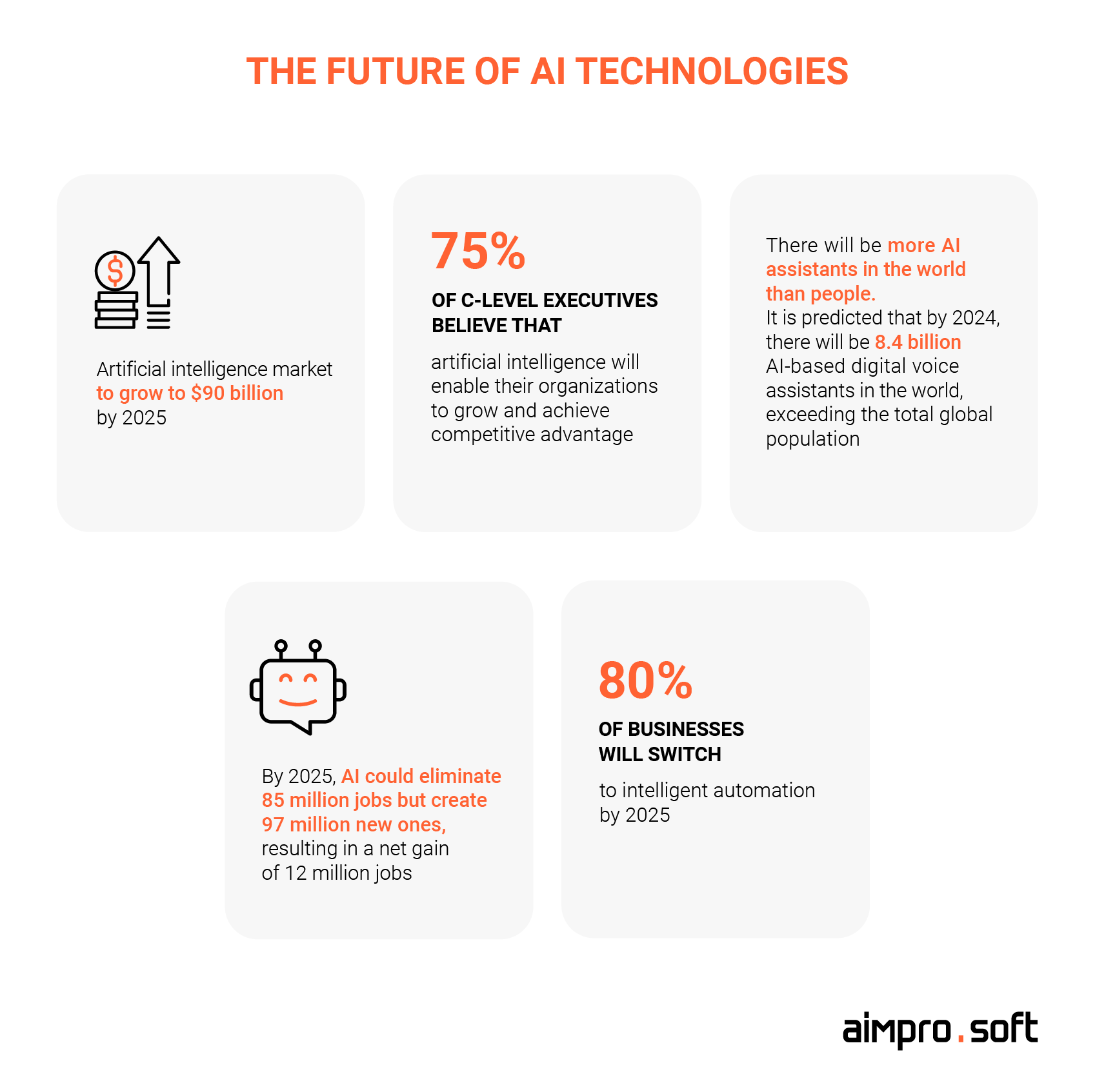
A compilation of surprising AI stats and predictions. Sources: UBS, MIT Sloan Management Review, Statista, World Economic Forum, Analytics Insight.
Artificial Intelligence trends
1. Reinforcement learning
Reinforcement learning, a subset of machine learning, shows tremendous potential in the future of Artificial Intelligence. It involves training AI systems through trial and error, rewarding success. AI predictions for the future are that as algorithms evolve, AI will become increasingly adept at self-improvement without direct human intervention, revolutionizing autonomous decision-making.
2. Advances in machine learning
AI and the future of unsupervised learning and reinforcement learning will receive more attention as machine learning advances. AI models will grow more effective and capable of resolving complicated issues, from self-driving cars to medical diagnosis.
3. AI technologies in recruitment
What is the future of artificial intelligence in this industry? A recent Pew Research Center poll showed mixed opinions: 47% believe AI can evaluate job applications better than humans, but 71% oppose using AI to make final hiring decisions. AI is expected to impact the workforce over the next two decades, and people are concerned about its personal impact. AI may replace some jobs, but it will also create new opportunities. Current AI tools like ChatGPT require human oversight for accuracy and context.
4. Ethical AI
As AI is more fully incorporated into society, ethical issues and responsible AI practices will receive increasing attention. A major concern will be ensuring fairness, openness, and accountability in AI systems. AI ethicists will be in greater demand as companies appear to show that they uphold moral principles and implement necessary protections.
5. Usage of AI in customer service
Due to the fact that customer service involves routine tasks, it is a great area for AI integration. So, how will artificial intelligence be used in the future in this sector? AI can automate routine jobs, freeing up workers to concentrate on more difficult issues. Incoming call prioritization, developing individualized solutions, and summarizing customer interactions are all made easier with its aid. In addition, a Boston Consulting Group poll found that 95% of customer service executives anticipate using AI bots to support customers within the next three years.
Artificial Intelligence in the future has considerable potential and development prospects in today’s world, as we can see from the statistics above. You can always follow the progress and start using AI technology for your needs, but remember always to be sure whether you require it or not.
Conclusion
AI represents the convergence of algorithms and data that imitate the cognitive activity of a human while distinguishing itself through its distinctive operational mechanisms. It doesn’t have emotions, consciousness, or the ability to think like we do, yet it has unprecedented capabilities. We have explored its intricacies, dispelled myths, and recognized its profound societal impact. AI is not some singular entity poised to overthrow humanity but a remarkable tool designed to improve our lives.
The future of AI in 2024 and beyond looks promising in all industries, and if you, too, consider incorporating AI technologies in your business but still feel hesitant, you can always contact Aimprosoft to consult on and dispel your doubts.
FAQ
How can artificial intelligence be risky?
Artificial intelligence can be risky in several ways. Firstly, it can inherit biases present in the data it’s trained on, leading to unfair or discriminatory decisions. Secondly, the lack of transparency in complex AI algorithms can make understanding how and why AI systems make certain choices difficult.
What will AI replace in the future?
AI in the future is likely to replace routine and repetitive tasks across various industries. This includes manufacturing jobs involving monotonous assembly line work, customer service roles that require scripted responses, data entry positions, and even certain aspects of healthcare like medical data analysis. However, AI is more likely to augment human roles rather than completely replace them, as it can enhance productivity and decision-making.
What is the future positive of AI?
The future of Artificial Intelligence holds several positive possibilities. AI has the potential to significantly improve efficiency in various sectors, from optimizing supply chains to automating administrative tasks. In healthcare, AI can enhance diagnostic accuracy and personalized treatment plans. Moreover, AI can contribute to scientific technological breakthroughs by processing vast datasets and simulating complex scenarios. It also has the potential to address global challenges like climate change through data analysis and predictive modeling. As we can see, these are just some of the reasons that confirm why AI is important to the future.
How can businesses prepare for the AI-driven future?
Businesses can prepare for an AI-driven future by investing in AI training and education for their workforce to adapt to new roles alongside AI systems. They should focus on data quality and ethics, ensuring that AI algorithms are fair and transparent. Additionally, companies should stay informed about AI advancements in their industry and collaborate with AI experts and startups to explore innovative applications. Developing a clear AI strategy and fostering a culture of responsible AI use are key steps in preparing for the AI-driven future.
What is Aimprosoft’s role in the future of AI technology?
In the future, we plan to keep growing in this field, and we are open to developing new AI projects. As an emerging and fast-expanding company, we will follow all AI trends and move towards a bright future. AI is growing fast, so we rapidly evolve and explore new AI technologies, models, and capabilities.




